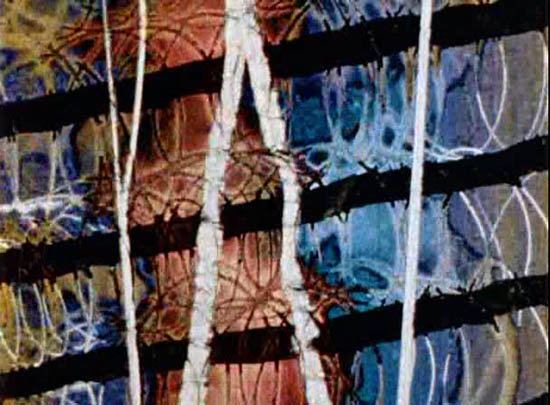 |
| Fig.1 - Norman McLaren |
"Abstract to the extreme, the latter synchronises a series of heterogeneous sounds to a ballet of blue dots executing evermore complex patterns as the soundtrack’s rhythm changes." Working straight on to the celluloid film he created a series of patterns and shapes that would move in harmony with the music. When the music reaches a crescendo the patterns movement would become faster between frames. The Layers of lines on top of the colours pick up the different layers within the music creating a visual metaphor of layers with the music. At times the screen becomes cluttered with pattern and colour that it becomes an eye sore, however when the music settles the relationship between the movement and the music can really be established. "I see movement, rather than specific images. . . . Movement is my basic language." (Sharman, L.F)
 |
| Fig.2 - Screen shot from 'Begone Dull Care' (1949) |

Fig.3 - Screen shot from 'Lines Horizontal' (1962)
Another one of McLaren's animations that isnt soft on the eyes, but it is fasinating to watch how our brains as humans can percieve shapes, perspective and movement from lines bouncing from top to bottom of the screen. As the lines move an illusion of rotating is created within the spaces between the lines as they become closer and move apart. At first the animation is easy to follow the pattern the lines are moving in but as there becomes more lines the harder it is to follow but hat is when the illusions really takes place, as the mind picks up of patterns emerging and disappearing before the audiences eyes. "In Lines Horizontal and Lines Vertical pure animation, in patterns of straight lines etched directly on the film interprets music by Pete Seeger and Maurice Blackburn respectively." (Willis, S.C, Wardrop, P)
A couple of years on from 'Lines Horrizontal' he produced 'Pas de Deux' in 1967. Greatly inspired by Eadweard Muybridge's work produced in the 1870's. Layering the film created a slow motion blur effect a step further on than Muybridge's studies by over lapping the moving images. The performace is unique and seem graceful and weightless from the slow motion waves higlighting every key frame in the couples movement,"a simple ballet performance transformed by its presentation to yield something that could only exist on film." (Coulthart, J, 2008)
List of Illustrations
- Fig.1 - Norman McLaren. Online at: http://www.cinema-scope.com/cs28/spot_koehler_mclaren_canadian.html
- Fig.2 - Screen shot from 'Begone Dull Care' (1949), Online at: http://deeperintomovies.net/journal/archives/date/2008/03/page/3
- Fig.3 - Screen shot from 'Lines Horizontal' (1962). Online at: http://mubi.com/users/106964/comments
Bibliography
- Melançon, P. Senses of Cinema, Begone Dull Care. http://www.sensesofcinema.com/2005/cteq/begone_dull_care/ (Accessed on the 22.03.11)
- Sharman, L.F. http://www.filmreference.com/Writers-and-Production-Artists-Lo-Me/McLaren-Norman.html (Accessed on the 22.03.11)
- Willis, S.C, Wardrop, P. The Canadian Encylopedia. http://www.thecanadianencyclopedia.com/index.cfm?PgNm=TCE&Params=U1ARTU0002301 (Accessed on the 22.03.11)
- Coulthart, J (2008.) Norman McLaren. http://www.johncoulthart.com/feuilleton/2008/04/12/norman-mclaren/ (Accessed on the 24.03.11)

No comments:
Post a Comment